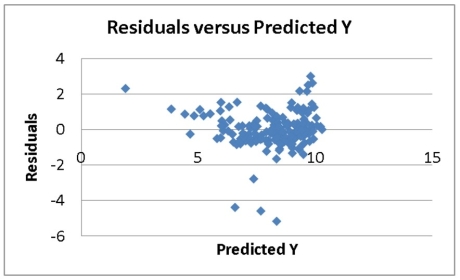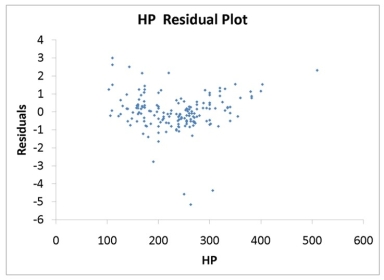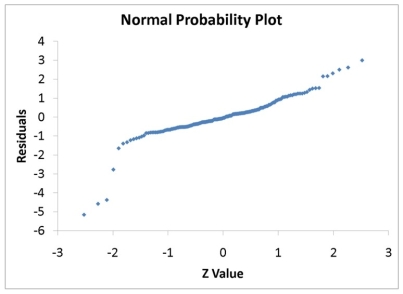TABLE 13-16
What are the factors that determine the acceleration time (in sec.) from 0 to 60 miles per hour of a car? Data on the following variables for 171 different vehicle models were collected:
Accel Time: Acceleration time in sec.
Cargo Vol: Cargo volume in cu. ft.
HP: Horsepower
MPG: Miles per gallon
SUV: 1 if the vehicle model is an SUV with Coupe as the base when SUV and Sedan are both 0
Sedan: 1 if the vehicle model is a sedan with Coupe as the base when SUV and Sedan are both 0
The regression results using acceleration time as the dependent variable and the remaining variables as the independent variables are presented below.

The various residual plots are as shown below.





The coefficient of multiple determination for the regression model using each of the 5 variables Xj as the dependent variable and all other X variables as independent variables (Rj2) are, respectively, 0.7461, 0.5676, 0.6764, 0.8582, 0.6632.
-Referring to Table 13-16, the 0 to 60 miles per hour acceleration time of a sedan is predicted to be 0.7679 seconds higher than that of an SUV.
Definitions:
Variable Manufacturing Overhead
Costs that fluctuate with the level of production output, such as raw materials and direct labor.
Predetermined Overhead Rate
A rate calculated before the accounting period begins, used to allocate manufacturing overhead costs to products.
Manufacturing Overhead
All indirect costs associated with manufacturing, excluding direct material and direct labor costs, such as utilities and rent for the manufacturing space.
Machine-Hours
A measure of the amount of time machines are used in the production process, used as a basis for allocating manufacturing overhead costs.
Q3: How many months in a year must
Q8: Executives receive _ as the difference between
Q11: In May 2014,the typical CEO earned approximately
Q13: Referring to Table 14-3, suppose the analyst
Q22: _ causes of variation are correctable without
Q44: Referring to Table 12-10, 93.98% of the
Q45: Referring to Table 11-10, which test would
Q51: Referring to Table 14-4, suppose the supervisor
Q153: Referring to Table 12-10, construct a 95%
Q182: Data that exhibit an autocorrelation effect violate